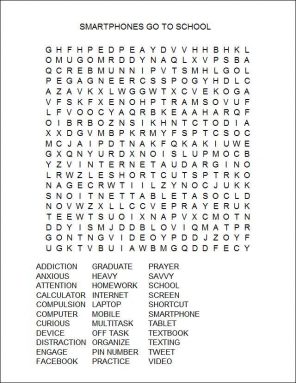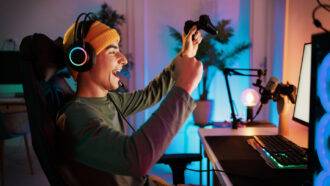When smartphones go to school
Work and grades tend to suffer when there is off-task use in the classroom
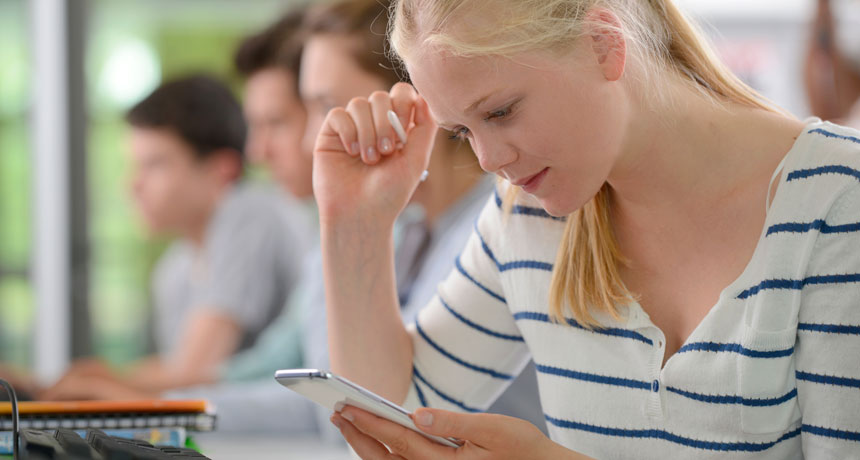
Some 73 percent of teens use smartphones, many times even at school. Studies find some use of smartphones can help class performance — others merely hurt it.
Goodluz/ iStockphoto
If you’re like most kids these days, you use a smartphone, and you use it often. You may even use that phone to text, tweet or go online during class.
In the United States, 73 percent of teens own or have access to a smartphone. A mere 12 percent have no cell phone. Those numbers come from a 2015 survey by the Pew Research Center in Washington, D.C.
Some 90 percent of teens with cell phones send texts. The typical number is 30 texts per day. That’s the median number from the Pew data. Additionally, the Pew report shows, 92 percent of teens go online daily. Almost one in four claims to be online “almost constantly.”
You need to be tech-savvy, both in and outside of school. But too much tech time at school for things other than classwork can cost you, new studies show. Unfortunately, kicking the habit of using cellphones and other mobile devices in class can be a hard.
Read on to see what scientists say about the use of smartphones and other mobile devices in class and what it could mean for today’s teens.
How mobile devices can help in class
Smartphones, tablets and other devices can be very handy at school. Curious about something the teacher said? A quick Internet search can turn up more facts. Want to prepare charts and present top-notch class reports? As the saying goes, there’s an app for that.

Mobile devices make it easy to type and organize notes. Calculator apps can help with math problems. Devices can even replace heavy, paper textbooks.
And that’s not all. “If we have these devices, we can do a lot of things around student interests and projects,” says Vincent Cho at Boston College in Massachusetts. For example, mobile devices often are cheaper and less bulky than regular computers. But, like regular computers, they allow Internet access. With that, students can share ideas and opinions within — or beyond — the classroom. Devices can connect interested students with groups and experts in that field as well.
Cho and Joshua Littenberg-Tobias, also at Boston College, recently surveyed teachers at a high school that urges all students to use mobile devices. In general, teachers felt these devices could improve learning, the Boston College team reported last April at a meeting of the American Educational Research Association. But teachers at that high school also were worried about their students becoming distracted.
The downside of mobile devices
Distraction by mobile devices is indeed something to worry about. Jeffrey Kuznekoff studies communications at Miami University Middletown in Ohio. For one recent project, he let college students take notes during a video lecture. Afterward the students took a test on the material. During the video, one group of students could text or tweet about anything. Another group could text and tweet only if the messages related to the lecture. A control group couldn’t text or tweet at all.
“Texting on things that are unrelated to class can hurt student learning,” Kuznekoff found. Overall, the control and class-related-message groups did 70 percent better on the test than did students that could text and tweet about anything. That control and relevant-message groups also scored 50 percent higher on note-taking.
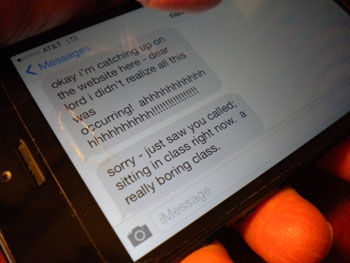
“You’re putting yourself at a disadvantage when you are actively engaged with your mobile device in class and not engaged in what’s going on,” warns Kuznekoff. His team shared its findings in the July 2015 issue of
Communication Education
.
Those findings mesh with what college students themselves report. Another new study found that the more time students said that they typically text, use social media or read online during class, the lower their grades are.
“A lot of students tend to think that they are good at multitasking,” or doing more than one thing at a time, says Saraswathi Bellur. She’s a communications researcher at the University of Connecticut (UConn) in Storrs. In fact, she and her colleagues found, multitasking in class “is likely to harm their academic performance.”
“We also have data that show that people who multitask during class or while doing homework have to spend more time studying,” notes UConn coauthor Kristine Nowak. In other words, she argues, students who use mobile devices for something other than research or note-taking during class “are not efficient, and it is costing them time.”
Concludes Nowak, “People believe they are better at multitasking than they are and this is leading them to bad study habits.” Her group shared its findings in the December 2015 issue of Computers in Human Behavior.
Drawn to distraction?
The classroom isn’t the only place where students use mobile devices when they should be focusing on something else. Talking and texting on cell phones play a role in more than one of four U.S. motor vehicle crashes. The National Safety Council in Itasca, Ill., made that estimate last May after reviewing 2013 data on road accidents.

In another recent study, many college students admitted that they often text, even when they know they shouldn’t. Examples included texting during prayer services or in romantic situations.
College students “seem to have almost a compulsion” to use their cellphones, says Marissa Harrison. “They can’t resist checking their cellphones for texts.” Harrison is a psychologist at Pennsylvania State University in Harrisburg who worked on this college-student study. Social Science Journal published her team’s findings in June 2015.
In extreme cases, using mobile devices and social media too much can turn into an addiction. By that, scientists mean people develop a compelling need to engage in some behavior, even when they know the consequences can be bad.
One August 2014 study showed that college-age cellphone users can show some of the same symptoms that drug addicts do. For example, some students felt anxious when their phone was not available. Students showing signs of addiction also spent more and more time using their phones. Many admitted their phone use was excessive. A second study that same month concluded that students can become addicted to Facebook (although better ways to measure that addiction are needed). The Journal of Behavioral Addictions published both studies.

Even where phone use isn’t quite addictive, the habit of using mobile technology can pull at our attention, notes Jesper Aagaard. He’s a graduate student in psychology at Aarhus University in Denmark. He recently interviewed 16- to 20-year old business-school students about their “off task” use of phones and tablet computers in class. “Off task” means that their use didn’t deal with the subjects being discussed in class. This scientist also spent six months observing students in class.
His conclusion: The habit of using mobile devices can pull students towards tasks “that tend to conflict with school use.”
For example, you might type your PIN, or personal identification number, without thinking whenever you pull out the phone. “The PIN, in other words, became embodied in your hand through practice,” says Aagaard. In the same way, you might unthinkingly open the texting screen, email or some app.
That process becomes even easier with shortcuts, such as typing “F,” “A,” and “enter” to open Facebook. So whenever they let their guard down, students quickly — and without thinking — log onto Facebook to check their notifications, Aagaard says. “In other words, they are drawn to distraction.” His study appears in the September 2015 issue of Computers & Education.
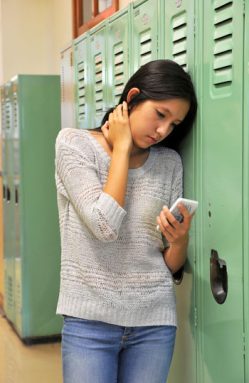
What should you do?
“Try to avoid splitting your attention” between what’s going on in class and whatever you might feel a need to do with your mobile device, advises Kuznekoff at Miami University. Otherwise, he says, “there’s a danger you’re spreading your attention too thin.”
“In order to pay more attention in class — or even outside of school — I recommend trying to obstruct your habits,” says Aagaard. For example, turn your cellphone or tablet off, or at least put it in airplane mode. Then you won’t wind up checking texts or using social-media sites without thinking.
Closing your laptop or tablet and putting your phone away more often could be good advice even outside the classroom. Stresses Harrison: “You’re going to miss out on a whole new and exciting world if you can’t get your head out of your phone screen.”
Power Words
(for more about Power Words, click here)
academic Relating to school, classes or things taught by teachers in formal institutes of learning (such as a college).
addiction The uncontrolled use of a habit-forming drug or uncontrolled and unhealthy behavior (such as video-game playing or phone texting). It results from an illness triggered by brain changes that occur after using some drugs or after engaging in some extremely pleasurable activities. Persons with an addiction may feel a compelling need to use a drug (which can be alcohol, the nicotine in tobacco, a prescription drug or an illegal chemical such as cocaine or heroin), even when the user knows that doing so risks severe health or legal consequences. (For instance, even though 35 million Americans try to quit smoking each year, fewer than 15 out of 100 succeed. Most begin smoking again within a week, according to the National Institute on Drug Abuse.)
airplane mode A setting on your phone or laptop that turns off all cellular, Wi-Fi, FM radio and Bluetooth connections. The device can still use apps that don’t need a cellular connection(including ones that let you listen to music or watch videos).
anxiety (adj.) A nervous or almost fearful reaction to events causing excessive uneasiness and apprehension. People with anxiety may even develop panic attacks.
app Short for application, or a computer program designed for a specific task.
control A part of an experiment where there is no change from normal conditions. The control is essential to scientific experiments. It shows that any new effect is likely due only to the part of the test that a researcher has altered. For example, if scientists were testing different types of fertilizer in a garden, they would want one section of it to remain unfertilized, as the control. Its area would show how plants in this garden grow under normal conditions. And that give scientists something against which they can compare their experimental data.
data Facts and statistics collected together for analysis but not necessarily organized in a way that give them meaning. For digital information (the type stored by computers), those data typically are numbers stored in a binary code, portrayed as strings of zeros and ones.
graduate student Someone working toward an advanced degree by taking classes and performing research. This work is done after the student has already graduated from college (usually with a four-year degree).
media (in the social sciences) A term for the ways information is delivered and shared within a society. It encompasses not only the traditional media — newspapers, magazines, radio and television — but also Internet- and smartphone-based outlets, such as blogs, Twitter, Facebook and more. The newer, digital media are sometimes referred to as social media.
median In statistics, the value in the middle of a group of data. Half the data points are at or above the median, while the other half are at or below that value.
multitask To perform more than one task at a time. Computers often do this. People can too, such as when they listen during a meeting and take notes at the same time. Research has shown, however, that few people can truly multitask well; usually, doing two or more tasks at once will mean that the quality of at least one of those tasks will suffer.
psychology The study of the human mind, especially in relation to actions and behavior. Scientists and mental-health professionals who work in this field are known as psychologists.
smartphone A cell (or mobile) phone that can perform a host of functions, including search for information on the Internet.
social media Internet-based media, such as Facebook, Twitter and Tumblr that allow people to connect with each other, often anonymously, and share information.
statistics The practice or science of collecting and analyzing numerical data in large quantities and interpreting their meaning. Much of this work involves reducing errors that might be attributable to random variation. A professional who works in this field is called a statistician.
subconscious An adjective for ideas or habits that occur without deliberately trying to think about them.
technology The application of scientific knowledge for practical purposes, especially in industry — or the devices, processes and systems that result from those efforts.
texting The sending of a text message from a mobile (cell) phone.
tweet Message consisting of 140 or fewer characters that is available to people with an online Twitter account.
Word Find (click here to enlarge for printing)
